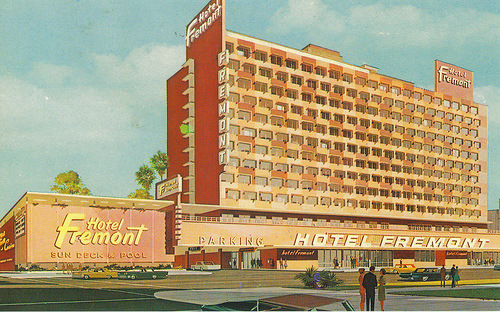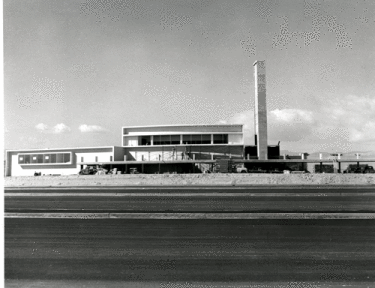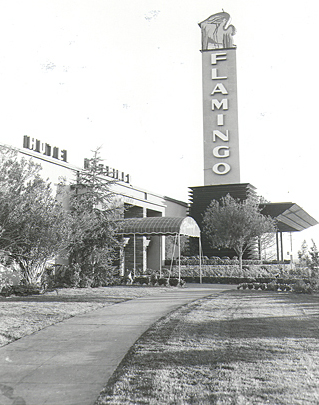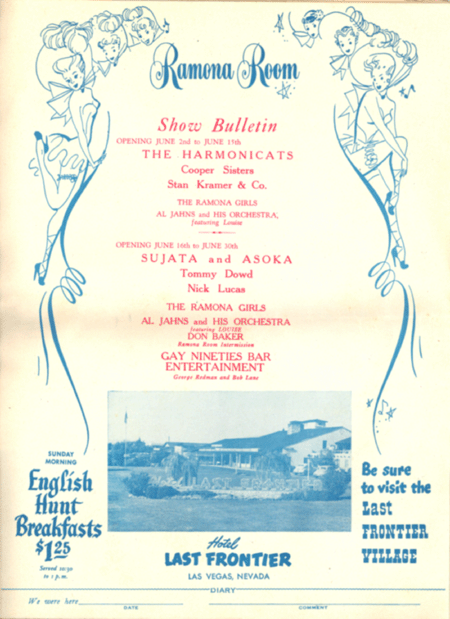As we get ready to celebrate the 40th anniversary of the King's comeback in Las Vegas, it's both sad and poignant to note that shows revolving around beautiful showgirls are all but a thing of the past. Forty years ago when Elvis came roaring back into town other must see shows included the Lido de Paris at the Stardust, the Casino de Paris at the Dunes, Pzzazz 69 at the Desert Inn and the Folies Bergere at the Tropicana. A few years later, Donn Arden- the man who had taken the idea of the showgirl revue to such heights raised the bar with "Hallelujah Hollywood!" at the original MGM Grand.
Today, Donn Arden is a distant memory to many who remember his name at all and all those shows are memories, too. But Arden's last show, "Jubilee", which took the place of "Hollywood" at the original MGM is still going strong. The original MGM Grand Hotel may be gone (today it is Bally's) but "Jubilee" and its focus on showgirls is still going strong.
One reason for that is Fluff LeCoque. Fluff started with Donn Arden fifty years ago as a dancer. She became a line captain and over the years became Arden's right hand assistant in all things related to his shows. She continues his tradition and his memory as the head of "Jubilee".
From our pal Jerry Fink at the Las Vegas Sun:
Las Vegas’ glorious, glitzy, glamorous past has atrophied to one show — an elegant topless production that celebrates its 29th birthday Friday.
“Jubilee!” — which features a cast of 80 and tons of feathers, rhinestones and sequined gowns — is the last of the enormous production shows. It was created by the late Donn Arden, who branded Las Vegas with such extravaganzas as “Lido de Paris,” which ran for 31 years at the Stardust, and “Hallelujah, Hollywood.”
Keeping Arden’s legacy alive is Ffolliott “Fluff” LeCoque, a former dancer who turns 86 on Aug. 7. She shows no inclination to make a final curtain call.
LeCoque manages “Jubilee!” with an iron fist wrapped in a velvet glove. She was born in Butte, Mont., where her father worked in copper mines and played baseball in summers. When she was 5 her family moved to Seattle, where she studied ballet, jazz and tap dancing before attending the University of Washington, where she studied acting. She moved to Hollywood and danced in Europe before settling in Las Vegas.
Q: Describe yourself.
I’m a bad loser. I’m determined to have my own way. I’ve always known who I am and what I am. I’m independent and difficult to handle. I like beautiful things. I love gardens. I love flowers. I like the outdoors. I used to be a pretty good athlete. I like people, but I don’t like to be around a bunch of people. I like small gatherings. I never thought I was beautiful, but I’m vain. How do you describe that?
What was your first professional job as a dancer?
It was at a nightclub in Hollywood, Calif. All the movie stars would go there. Now it’s a parking lot.
Did you go to Hollywood to dance or to get into the movies?
I went to the University of Washington where I studied to be an actress. I went to Hollywood to try to get into the movies and to dance on the side — it was something I could work at and make a living at till I got a job in the movies. But my movie career didn’t last long. I was up for the part of Jane in the new Tarzan movie series (starring Lex Barker). I can’t remember the girl who was Jane (Brenda Joyce, who died recently at age 92). Anyway they were casting and I went to see the casting director. He looked at my picture and asked me to stand up and turn around. I did. He said, “I see you’re a dancer.” I had more muscle in those days than girls were supposed to have. He said, “Well, how would you like to teach me how to dance?” I said, “I think you should try out for the part of the gorilla” and left. I didn’t get any callbacks.
Did you ever break into films?
I danced in a couple of movie shorts. I did a film at Moulin Rouge that they still sell today —“Fresh From Paris” (1955), starring Forrest Tucker.
How did you end up in Las Vegas?
After Hollywood I worked at the Thunderbird hotel in Vegas as a dancer. Then I went back to Hollywood, then back to Vegas. Shows then only lasted two or three weeks so I went back and forth a lot. Finally, I wound up in Europe.
How did you meet Donn Arden?
I was a principal dancer in several shows in Europe. He saw me there but we didn’t meet until sometime later. After I returned from Europe I went to New York to his office to audition for the Arden-Fletcher Dancers (Donn Arden/Ron Fletcher). They already knew about me and hired me and I went to Cincinnati to work for Donn, but I still hadn’t met him. Around that time the Desert Inn in Las Vegas was putting in a new stage and they wanted Donn there. Donn’s office asked me if I would go there. The first time I ever met Donn was 1951 or ’52 at the Desert Inn. Those shows didn’t have names in those days. Basically, they were floor shows in a nightclub setting — you would have dinner and then dancing with a full orchestra. They were called floor shows — when people were dancing, the shows would be on sunken floors and when the shows came on, the floors would rise up a little higher. There were never any sets or anything.
What was your relationship with Arden?
He was a very good friend. We were very close. He was a very creative person. He knew what he wanted. He used to yell a lot. He could do it then. You had to respect Donn because he knew exactly what he wanted. That’s why he’s lasted so many years. He never really received the credit he was due. He put shows on that put this town on the map.
When did you quit dancing?
I quit dancing after my last show at the Desert Inn (1966). I was not really dancing then, I was more of a company manager. I was 43 when I quit dancing. Then I basically retired and took up painting. I also did publicity. I was a writer for the Las Vegas Art Museum. I guess about three years went by and they called me to come and manage “Hallelujah Hollywood,” Donn’s show at the old MGM Grand (now Bally’s). I’ve been on this property since 1973 — first with “Hallelujah Hollywood” and since 1981 with “Jubilee!”
As manager, what are your duties? Are you a part-time mother confessor?
Not really so much anymore because of rules and regulations and policies. I’m not as personable as I used to be, not involved in their personal problems as much as I used to be in years gone by. Sometimes I’m like a mother figure to them but my job is to see that they get onstage every night, do what they’re supposed to and to follow the rules and regulations.
How has “Jubilee!” evolved?
It’s pretty much exactly the same. We have changed the opening number. The first production had five segments in it, now there are three. We have changed some numbers in the finale. It hasn’t changed that much.
Would you say it still reflects a Las Vegas that doesn’t exist anymore?
Yes, it does. It’s glamorous. It’s in very good taste. It’s enticing, but not vulgar. Even though we have topless girls, you forget about it after a while. That’s not the focus. It’s really Donn Arden’s ideal. He loved singers, he loved dancers, he loved beautiful women. Everything he did was to make even a pretty girl more beautiful.
What about your job, how has it evolved over the past 28 years?
I can’t yell at the dancers anymore. I used to be able to. I still frighten them. Every time I call them into the office over the loudspeaker, they feel like they’re going into the principal’s office. The job has changed in many ways. Now the computer has taken over. I spend a lot more time on computers than ever had to before. That has given me less time to watch the show, which is why I have a big monitor on the office wall. My assistant, Diane Palm, and I are both on the computer all the time, doing payroll and tracking and keeping records. We have to do all that now. It all goes on computer. That’s the big change. Also, corporate polices. The hotel owns the show so we have to follow their rules and regulations like any employee. We have to be sure to adhere to corporate policy, be courteous to people. I can’t, shouldn’t, yell at them or demean them or anything like that. Whereas I used to say “You’re fat. Get off my stage,” now I can only say “I think you need to lose a few pounds.”
You were a dancer in Las Vegas’ most colorful period. Do you have any regrets?
I was strictly focused on business. I was also married or about to be married or something. I didn’t go with the fast track. I didn’t run with the mob at all. I minded my own business.
What do you feel about the new Las Vegas?
I don’t like it. They’re advertising too much sex, all over the place. Vegas wasn’t like that. Even though there has always been prostitution and call girls, it was not thrown in your face as it has been in the last few years. If Vegas wants to come back, it’s going to have to calm down. It’s gotten way out of hand.
What keeps you going?
I love my job. I love the work. I think about stopping sometimes. I think about it, but I just keep going. Being around young people all the time renews my spirit, even with all the problems that they give me sometimes. It’s a challenge every night, every show.
Do you have interests outside the show?
Not anymore. I used to garden a lot, now I hire somebody to do it and I oversee them. I hardly ever watch television. When I go home at night I very seldom turn it on. I’m surrounded by sound and noise all the time. When I go home I open my sliding glass door go out into the back yard where I have a big fish pond and waterfall and I sit and calm down.






